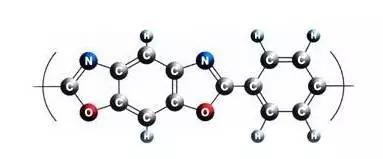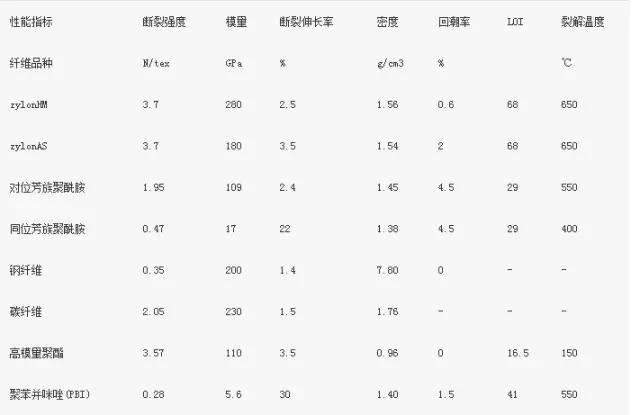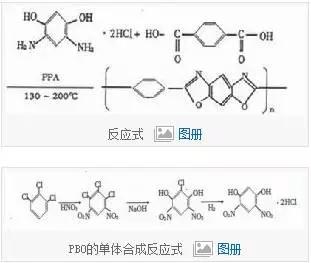PBO fiber PBO is the abbreviation of Poly-p-phenylenebenzobisthiazole. It is a reinforcing material for composite materials developed by the United States for the development of aerospace industry in the 1980s. It contains a heterocyclic aromatic compound. One of the most promising members of the family of polyamides is known as the 21st century super fiber. Development History The PBO was invented by the US Air Force aerodynamic development researcher. First, the Stanford University Research Institute (SRI) owned the basic patent for polybenzoxazole. Later, the US Dow Chemical Company was authorized and PBO has been industrially developed, and the original monomer synthesis method has been improved. The new process has almost no isomer product by-products, which improves the yield of synthetic monomers and lays the foundation for industrialization. In 1990, Toyobo Co., Ltd. purchased PBO patented technology from American Road Chemical Company. In 1991, Dow-Badi Xu Chemical Fiber Co., Ltd. developed PBO fiber on the equipment of Toyobo Co., Ltd., which greatly increased the strength and modulus of PBO fiber to twice the P PTA fiber. In 1994, Japan’s Toyobo Co., Ltd. was granted the permission of Dao-Badi Xu Chemical Fiber Co., Ltd., and invested RMB 3 billion to build a 400-ton/year PBO monomer and 180-ton/year spinning production line, and began to invest in the spring of 1995. Mechanized production, the production capacity in 1998 reached 200 tons / year, the trade name is Zylon. According to Toyobo's development plan for Zylon, the production capacity in 2000 will reach 380 tons/year, in 2003 it will reach 500 tons/year, and in 2008 it will reach 1000 tons/year. Today, Toyobo is still the only company in the world that can commercialize PBO fiber. Prospects for PBO fiber development In recent years, high-performance fiber composite reinforcement materials have been widely used in high-rise buildings, large bridges, and marine engineering in developed countries such as Europe, America, and Japan, and the fiber cloth impregnated epoxy resin is attached to the concrete surface, which can greatly improve the original. The carrying capacity of the structure and the ability to withstand earthquakes. In addition, in the construction of bridges, steel cables cannot be used for long-length bridges because of their own weight, but it is desirable to use cables with light weight and high strength. The cables made of PBO fiber with high strength and good dimensional stability are the best. s Choice. PBO fiber is gradually replacing the traditional material asbestos in the field of heat-resistant materials, and it is still exploring the replacement of flame-retardant fibers such as aromatic polyamide with PBO fiber in applications below 350 °C. In the application of 350 ° C or more to replace inorganic fibers such as stainless steel fiber or ceramic fiber, because the inorganic fiber is hard, the product is prone to scratches, affecting its performance, and PBO fiber is completely possible to overcome the shortage of inorganic fiber. In the past, organic fibers have insufficient heat resistance (more than 400 ° C), which limits the development of organic fibers. The decomposition temperature of PBO fibers reaches 650 ° C, which is the highest heat resistance temperature of all organic fibers. Therefore, it is entirely possible to replace the PB0 fiber with the PB0 fiber in the application field where it is difficult to use the organic fiber at 350 ° C or higher, and the application of the PB0 fiber heat-resistant material can be broadened and developed. Foreign studies have shown that PBO fiber has many uses in other fields such as electrical insulation materials, satellite detection, lightweight materials, automotive industry and deep sea oilfield development. As a high-speed train body, PBO fiber can not only reduce the body quality, but also increase the strength of the car body; it can be made into various corrosion-resistant protective clothing by using PBO fiber chemical resistance; in order to reduce the limited burden in aerospace, PBO fiber is suitable. It can be used as a button, belt, etc. for space use; it can also be used as a material for heat-resistant probe balloons in a space environment ranging from -10 ° C to a surface temperature of 460 ° C; It is mainly made of sheet-like thin plate material made of high-strength and high-mold fiber. In order to minimize the deformation of the canvas when it is blown by the wind, it is necessary to find the PBO fiber with the highest modulus to make the sail for rowing; in view of the PBO fiber Excellent mechanical properties, it is also the best material for making golf clubs, tennis rackets, ski poles, snowboards, surfboards, archery bowstrings, and bicycle racing. The development and industrialization of key technologies of PBO fiber can make China's PBO fiber get rid of the long-term monopoly of foreign technology monopoly and control, and embark on a road of localization and large-scale development of PBO fiber with independent innovation, bright prospects and broad application. It contributes to the development, application and sustainable development of high-performance PBO materials such as aerospace, defense, military and civil industries. Fiber properties According to Toyobo, its high-end PBO fiber product has a strength of 5.8GPa (measured as 5.2GPa in Germany) and a modulus of 180GPa, which is the highest among the existing chemical fibers; the heat-resistant temperature reaches 600°C, and the limiting oxygen index is 68. The flame does not burn, does not shrink, and has higher heat resistance and flame retardancy than any other organic fiber. Mainly used in heat resistant industrial textiles and fiber reinforced materials. Performance comparison between PBO and other high performance fibers: It can be seen from the table that the strength, modulus, heat resistance and flame resistance of the PBO fiber, especially the strength of the PBO fiber, not only exceed the steel fiber, but also override the carbon fiber . In addition, PBO fiber is excellent in impact resistance, abrasion resistance and dimensional stability, and is light and soft, making it an extremely desirable textile material. As a 21st century super performance fiber, PBO has excellent physical and mechanical properties and chemical properties. Its strength and modulus are twice that of Kevlar fiber and it also has the heat-resistant and flame retardant properties of meta-aramid. The physicochemical properties are completely beyond the Kevlar fiber that has been leading the way in high performance fiber. A 1 mm diameter PBO filament can lift up to 450 kg and its strength is more than 10 times that of steel fiber. PBO fiber surface modification The TIFSS between the PBO fiber and the resin matrix is ​​increased, but too much coupling agent will cause the crosslinking agent cross-linking layer to be too thick, but the TIFSS will decrease. The etching effect of the plasma on the fiber surface first acts on the coupling agent, so that The coupling agent forms a graft cross-linking layer, and the coupling agent layer can protect the fiber, so the σ of the PBO fiber decreases little. The analysis shows that the coupling conditions of the coupling agent and the plasma are modified: the content of the A-187 coupling agent is 2%, the time of the argon low-temperature plasma treatment is 2 min, the pressure is 5Opa, and the power is 30W. Among the selected coupling agents, the A-187 coupling agent has the best effect on improving the development of PBO fiber and IFSS between epoxy resins, and the optimum content of coupling agent is 2%. (1) When the A-187 content is 2% and the argon low temperature plasma treatment condition is 2min, 30W, 50Pa, the modified PBO fiber has a ΓIFSS胂 of up to 104.MPa, compared to the coupling agent A-187 only. The modified ΓIFSS increased by 52% and the ΓIFSS relative to the original yarn increased by 78%. The wettability of PBO fibers has also been greatly improved. (2) The PBO fiber modified by argon low-temperature plasma-bonding coupling agent has a significant decrease in ΓIFSS with time; the increase of contact angle is not obvious, and its change tends to be stable and slightly decreased. trend. The attenuation effect of argon low temperature plasma combined with coupling agent modified PBO fiber is not obvious. preparation PBO is prepared by solution polycondensation of 4,6-diaminophenol hydrochloride (diaminoresorcin hydrochloride) and terephthalic acid with polyphosphoric acid (PPA) as solvent, and can also be dehydrated by P2O5. Polycondensation, PPA is both a solvent and a polycondensation catalyst. The synthesis of monomeric diaminoresorcinol was successfully synthesized by American Dow Chemical Company with trichlorobenzene as the starting material, so that no isomers were formed during the synthesis, and the yield was high. Industrial production of PBO It has played a big role. The polymer spinning solution is spun, washed with water and dried by dry-wet spinning. The spinning solution dissolves into the liquid crystal. When the spinning is performed by the liquid crystal spinning method, the stretched chain structure can be formed, and the as-spun yarn (AS wire-standard type) has a strength of 3.53 N/tex or more and an elasticity of 10.84 N/tex or more. Modulus. In order to increase the modulus, heat treatment may be carried out at a temperature of about 600 ° C to obtain a high modulus yarn (HM filament - high modulus type) having a modulus of 176.4 N/tex and a constant strength. application The main features of PBO fiber are heat resistance, high strength and high modulus, so it is widely used. (1) Application of filaments, reinforcing materials for rubber products such as tires, tapes (transport belts), rubber hoses; reinforcing materials for various plastics and concrete; reinforcing components for ballistic missiles and composite materials; fiber optic cables Protective film for tension members and cables; reinforcing fibers for various cords such as electric heating wires and earphone cords; high tensile materials such as ropes and cables; heat-resistant filter materials for high-temperature filtration; protective equipment for missiles and bullets, bulletproof vests, Bulletproof helmets and high-performance sailing suits; tennis equipment, speedboats, rowing and other sports equipment; advanced loudspeaker vibrating panels, new communication materials; aerospace materials. (2) Short-cut fiber and pulp application, can be used for reinforcing fibers for friction materials and gaskets; various resin, plastic reinforcement materials. (3) Application of yarn, which can be used for fire-fighting clothes; heat-resistant overalls for handling molten metal on site, such as work clothes and welding work clothes; protective clothing for anti-cutting, safety gloves and safety shoes; racing suits and riders; Sportswear and active sports equipment; Carrace pilot suits; anti-cutting equipment. (4) Application of short fibers, mainly used for heat-resistant cushion felts for aluminum extrusion processing; heat-resistant filter materials for high-temperature filtration; heat protection belts. Rayon dyed fabric is a type of fabric made from rayon fibers that have
been dyed with color. Rayon is a semi-synthetic fiber made from
cellulose, which is derived from wood pulp or other plant materials. It
is known for its softness, drape, and ability to absorb and retain dyes. Rayon Dyed Fabric,Bright Colour Fabric,Brightly Painted Fabric,Comfortable Soft Fabric Shaoxing Funshion Textile Co.,Ltd , https://www.nbcasualshirts.com



Dyeing Rayon Fabric involves immersing the fabric in a dye bath or
applying the dye directly to the fabric. The dye molecules penetrate the
fibers, resulting in a permanent color change. Rayon is known to take
on vibrant and rich colors, making it a popular choice for clothing,
home textiles, and other applications.